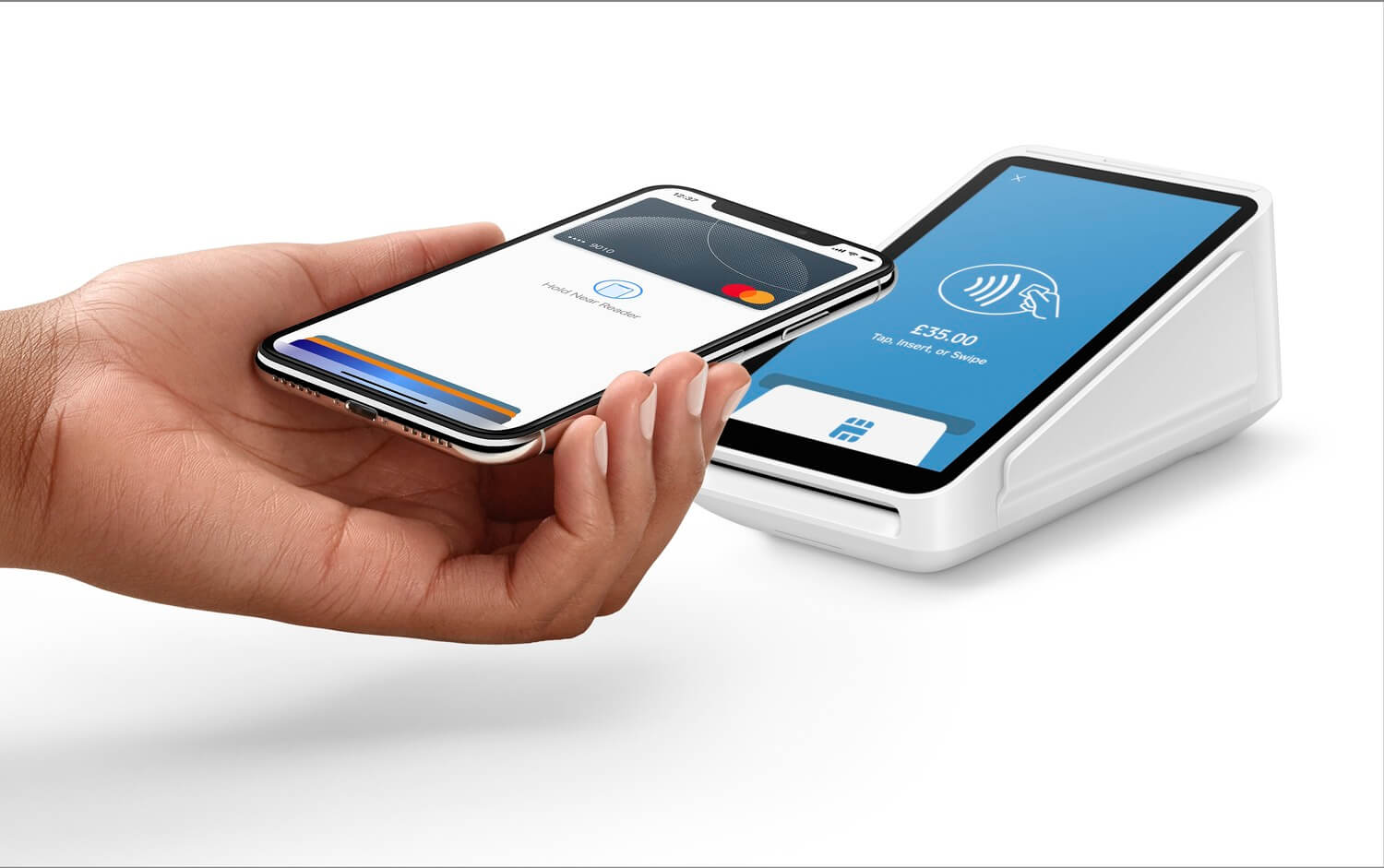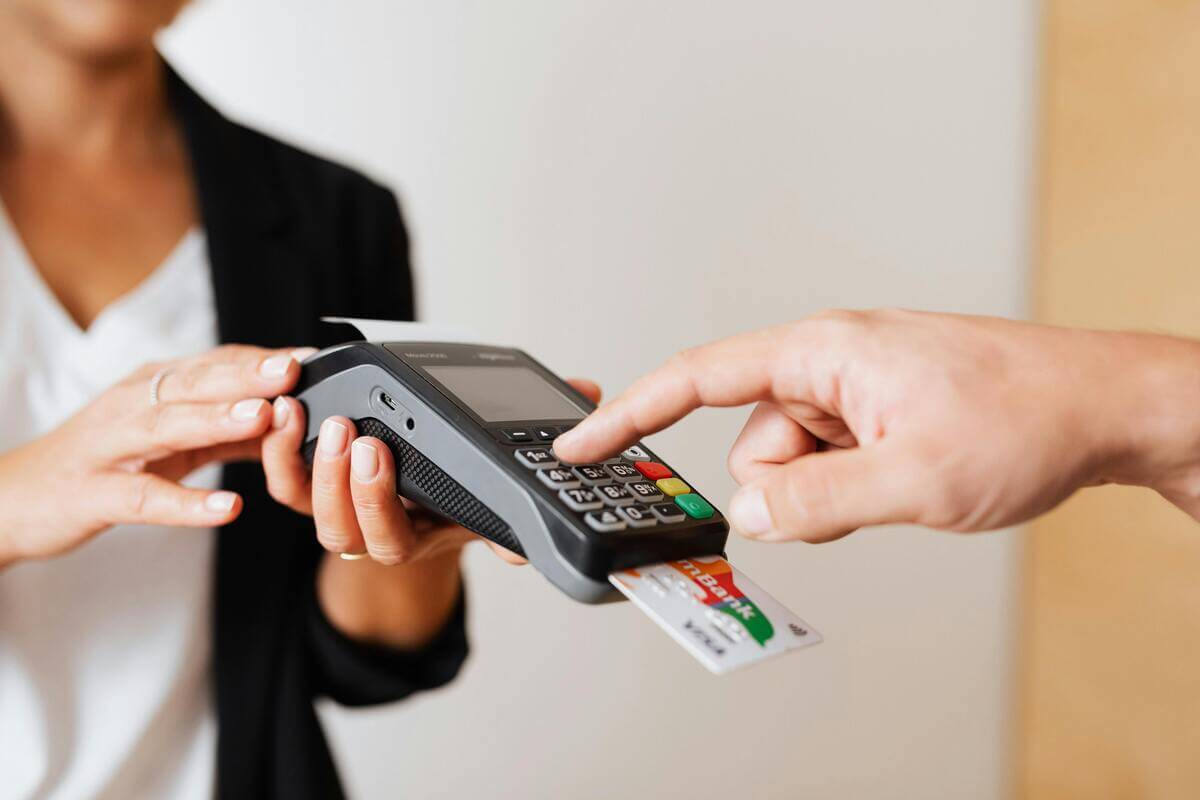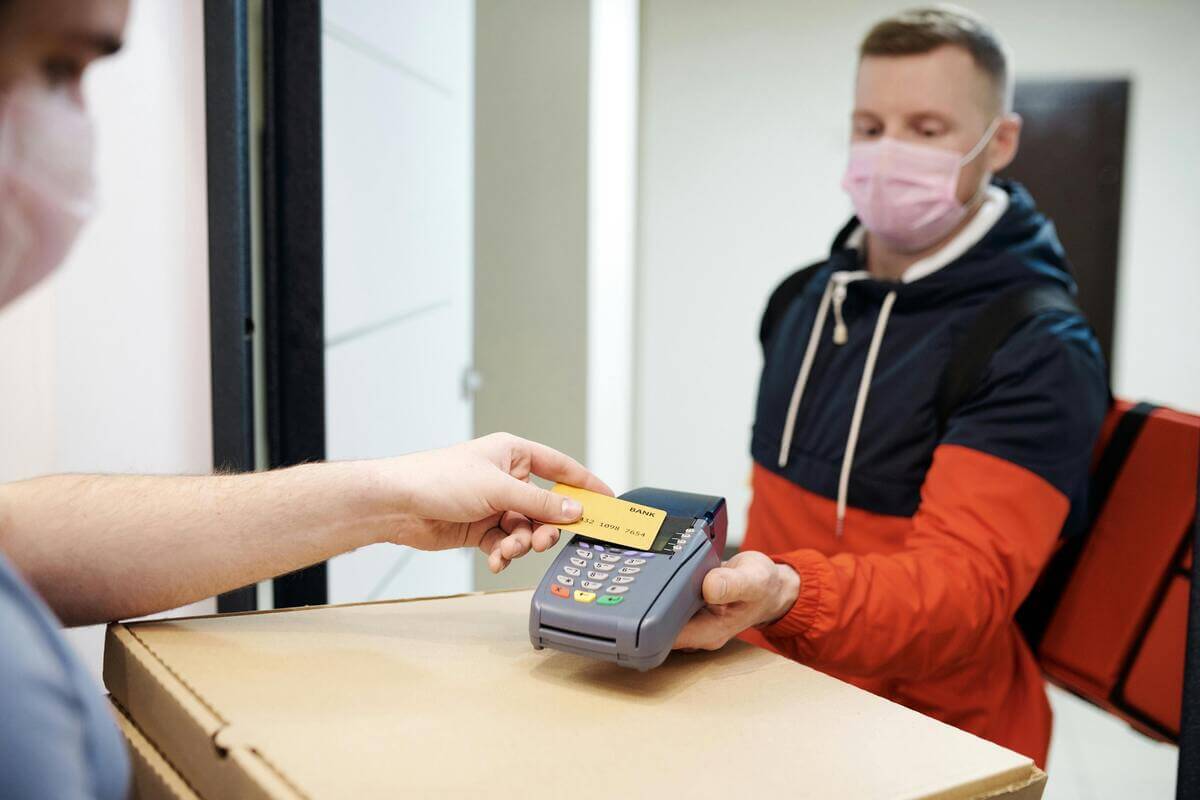Nowadays, cash is no longer the only payment method. People can make purchases with debit cards, credit cards, e-wallets, and bank transfers. In 2023, 69% of U.S. online adults had paid for a purchase using a digital payment method over the past three months. Offering multiple payment options not only brings convenience to customers but also removes potential obstacles to business sales.
When your customers make electronic transactions, the banks or payment processors will charge you some fees for using their payment gateways. While these fees may appear small, they can accumulate and eat into your profit margins if left overlooked. Thus, you should understand the transaction fee definition, all types of transaction fees you may encounter and how to minimize them. Let’s discover these points in this article.
What is a transaction fee?

Contactless payment via Square terminal
A transaction fee is the service fee charged by the payment processor for each electronic transaction to maintain payment infrastructure, prevent fraud, and guarantee a successful transfer.
FYI, a payment processor is a system that enables merchants to accept customer payments via credit cards, debit cards, and bank accounts.
How much is a transaction fee?
The specific fee amount depends on your selected payment processor. Most processors charge a percentage of the transaction’s value, which typically ranges from 0.5–5%. Other times, they can impose a fixed additional charge. Here are some examples:
Payment processor | Swiped transaction fee | Online transaction fee |
PayPal | 2.99% + $0.49 | 3.49% + $0.49 |
Square | 2.6% + $0.10 | 2.9% + $0.30 |
Stripe | 2.7% + $0.05 | 2.9% + $0.30 |
Sources: Square and PayPal pricing pages
Who pays credit card transaction fees?
Usually, merchants are responsible for covering processing fees, but in some cases, they might pass on the cost to their customers, for example, if the customers use credit card surcharge programs. However, most customers don’t like surcharges. According to a Lending Tree survey, 57% of American cardholders think charging consumers transaction fees should be illegal.
Because of transaction fees, some small merchants require a minimum purchase amount (e.g. $5 or $10) for customers to use cards or electronic payments, as they can’t bear the fees for low-value transactions.
Thus, to minimize the impact of transaction fees, you should select a payment processor with more favorable rates for your business.
Types of transaction fees

Flat fee
A flat fee is a fixed amount the payment processor charges you per transaction, regardless of its value.
If the transaction amount is small, the total fees may increase your costs. On the other hand, if you process large transactions, the fixed fees will impact your business less.
For instance, if the imposed flat fee is $0.20, then for 10 transactions, you’ll have to pay a total fee of $2, no matter the type of card your customers use, how the transactions are processed, and how much money is transferred.
Here are some payment gateways that impose flat fees:
- PayPal: $0.49
- Square: $0.10 for card present, $0.15 for keyed transactions, and $0.30 for online payments
- Stripe: $0.30
- Braintree: $0.49
- Adyen: $0.13
- Paysafe: $0.10
Percentage fee
A percentage fee is a variable amount set as a percentage of the total transferred amount. The percentage can vary from 0.5–5% depending on the payment processor, but typically around 2–3%.
When transactions are too small, a flat fee might also be added to the percentage fee, or serve as a minimum charge instead. Generally, percentage fees impact your business more significantly than flat fees for larger transactions.
For example, your business receives $100 from a customer, the percentage fee is 2% and the flat fee is $0.20. In this case, you would have to pay 2% of $100 plus $0.20, making a total fee of $2.20.
Some payment gateways that charge percentage fees include:
- PayPal: 3.49% for most online payments
- Square: 2.6% for card present, 2.9% for online payments, and 3.5% for keyed transactions
- Stripe: 2.9%
- Braintree: 2.59%
- Paysafe: 0.30%
What are the components of transaction fees?

There are 5 main components of transaction fees, including interchange fees, card scheme fees, acquirer fees, gateway fees, and international transaction fees.
Interchange fees
An interchange fee is a payment that a customer bank (an issuing bank) receives from a merchant bank (an acquiring bank) for processing a card-based transaction.
Each card scheme sets its own interchange fee which is non-negotiable and varies depending on the following elements:
- Card types: Debit or credit
- Card schemes: MasterCard, Visa, American Express, Discover, etc.
- Merchant type and size
- Where the sale happens: Domestic, cross-border, etc.
- How the transaction is processed: Card-present, card-not-present, online, in-store, etc.
Card scheme fees
A card scheme fee or card network fee is like a membership fee that an acquiring bank pays to join a payment network. The acquiring bank then passes this fee on to the merchant through the transaction fee.
Factors like card type, payment method, and the geographic location, may impact the card scheme fee.
Acquirer fees
An acquirer fee, also called acquirer markup, is the fee that goes to the acquiring bank (or acquirer) or the payment service provider (PSP) to cover the acquiring services.
If a merchant works directly with an acquirer, the entire acquirer fee will go to that bank.
If your business works with a PSP, which partners with multiple acquirers, you’ll have to pay the acquirer fee plus an additional fee for their services, like offering connections with many acquirers and payment methods.
Unlike the interchange fee, the acquiring fee is negotiable and may fluctuate based on the bank, card type, business type, transaction volume, and other factors that may affect the business’s risk profile.
Gateway fees
When accepting an online payment through a payment gateway, the merchant incurs a gateway fee, which is subject to the online transaction value and the chosen payment method.
International transaction fees
Credit card issuing banks charge customers a foreign transaction fee for electronic transactions abroad or with foreign vendors.
Terms and conditions of the credit cards will determine the international transaction fees. Some banks don’t collect this fee, while others may charge from 1–3% of each transaction in U.S. dollars.
What factors influence transaction fees?

The cost of electronic transactions relies on card type, card scheme, transaction type, transaction volume, geographic factors, and merchant type.
Card types
Transaction fees might differ due to the type of card used. Generally, debit cards have lower fees than credit cards because they are less risky.
For example, Helcim’s average rate for an in-person credit card transaction is 1.93% + $0.08, while the average PIN-Debit rate is 1.01% + $0.08.
Card scheme
Card schemes or card networks set the interchange rates, which are usually the largest element of the transaction costs.
Some card networks like Visa and MasterCard publish their interchange rates, while Discover, American Express, and JCB don’t.
You can see the interchange fee rates of Visa and MasterCard below:
- Visa: 1.4–2.5% for credit cards and 0.05% for debit cards
- MasterCard: 1.5–2.6% for credit cards and 0.05% for debit cards
Transaction volumes
Transaction volumes refer to the number of electronic transactions that a merchant processes each day. A merchant with high transaction volumes can negotiate lower per-transaction fees.
Geographic factors
Geographic factors such as local compliance requirements and currency exchange rates might influence the transaction fees.
For example, PayPal charges a lower fee of 3.5% when converting to U.S. or Canadian dollars and a 4% fee for other currencies.
Business type
Higher-risk industries, for instance, telemarketing, travel, online gambling, and adult entertainment, may have to pay higher transaction fees because they pose more risks of chargebacks and fraud.
On the other hand, lower-risk industries, such as supermarkets and nonprofits, often pay lower fees.
Transaction type
Each type of transaction poses a different level of risk, thus affecting the transaction fee differently.
For example, card-present transactions usually involve lower fees than card-not-present ones. The physical presence of the card makes transaction verification easier, thereby lowering the risk of fraud.
How to calculate transaction fees?
You can figure out transaction fees based on the flat fee and percentage rates based on the fee structures and policies of each payment service provider.
Here’s the formula:
Transaction fee = Transaction amount x Percentage fee rate + Flat fee
Let’s look at an example.
Your business has to pay a percentage fee of 5% and a flat fee of $0.30 for each transaction. When a customer makes a $500 purchase from your business, the transaction fee will be:
Transaction fee = $500 x 5% + $0.30 = $25.30.
How are transaction fees collected?

Typically, the service provider will charge transaction fees during the payment processing stage. Nevertheless, they can gather these fees in different ways.
Direct deduction from the payment
Payment processors often deduct the transaction fee directly from the payment before depositing the remaining amount in your merchant account.
Invoicing
On some occasions, such as high-volume or business-to-business transactions, you might receive a separate invoice for your transaction fees. And you’ll have to pay them within a specific time limit.
Buyer-borne fees
In some cases, especially international transactions and specific payment methods, buyers may have to bear currency conversion fees or convenience fees. You’ll see these fees during the checkout process.
Impacts of transaction fees
Transaction fees can affect both your business and customers in 4 main ways.
Lower profitability
First, they eat into your overall profitability, which could prevent your business from growing and maintaining competitive prices. Typically, small businesses and entrepreneurs are the most vulnerable to this impact.
Increase pricing
When trying to relieve the influence of transaction costs, businesses might pass some fees to customers by raising the prices of goods and services. However, the higher the price, the less the quantity demanded will be. This ends up impacting your sales volume and profit margins.
Hinder customer satisfaction
Another effect of high transaction fees is on the checkout experience of customers. Unwanted fees imposed on consumers can detract from their experience, sometimes leading to shopping cart abandonment.
Limit payment choices
Transaction fees can also limit the payment methods that businesses offer to customers. On the one hand, merchants may encourage their buyers to use certain payment methods to lower the fees. On the other hand, customers may prefer other options which they find more convenient and beneficial for them. If the customers don’t find their preferred payment options, they may opt for your competitors.
10 ways to minimize transaction fees

You can resort to some strategies below to lower transaction fees for your businesses.
1. Evaluate payment processor options
Different payment processors have varying fee structures and terms, so you should research and evaluate which is right for your business transaction patterns.
Here are specific criteria you should compare:
- Non-qualified surcharges
- Per transaction fees
- Monthly or annual fees
- Batch fees
- Setup fees
- Termination fees
- Chargeback fees
2. Negotiate fee rates
If your business has a high transaction volume or an established sales history, you can negotiate with the payment processors to secure more favorable rates.
3. Encourage debit card usage
For merchants, debit cards are cheaper to process than credit cards. You can apply incentives and discounts to encourage debit card payments and reduce total fees.
4. Integrate Address Verification Service
Address Verification Service (AVS) is a security measure that helps prevent fraud in online transactions to reduce transaction fee chargebacks.
5. Establish minimum transaction amounts
This strategy helps merchants protect their margins by addressing high fees for small transactions.
6. Process transactions in one batch
Batch card processing can be more cost-effective for merchants than real-time processing because it reduces the number of separate transaction fees.
7. Review merchant account statements regularly
Merchants should review account statements regularly to notice any changes in transaction fee regulations.
8. Utilize off-peak hours
Businesses can leverage certain payment processors that offer lower fees for transactions during off-peak hours to cut costs on batch processing.
9. Resort to modern technology
Take advantage of modern point of sale (POS) technology. POS systems for specific eCommerce platforms like Magento POS and POS for Shopify not only offer faster transactions and enhance accuracy but also help collect customer feedback and insights to improve your operations.
Some POS systems can integrate with multiple payment processors, like the Magestore Stripe POS system or Magestore Square POS system, giving you flexibility in choosing payment providers and finding the one with transaction fees that best fits your business.
10. Provide alternative payment options
Accepting bank transfers, digital wallets, and alternative payment methods can help you reach a wider consumer base and avoid high credit card transaction fees.
Conclusion
In a nutshell, a transaction fee is an expense paid to the payment service provider when processing each electronic transaction.
Transaction fees can vary based on the fee structures of providers, but payment processors usually charge them as a percentage of the transaction amount or a fixed fee per transaction.
Understanding how transaction fees work and strategies to reduce them helps boost your businesses’ profitability and long-term success.
FAQs
1. Which bank does not charge foreign transaction fees?
- Capital One’s online bank charges no currency conversion fees or foreign ATM network fees.
- Charles Schwab Bank doesn’t charge currency conversion fees for debit card transactions or using debit cards at ATMs overseas.
- Discover® Bank doesn’t charge foreign transaction fees or foreign ATM networks.
- Some HSBC credit cards including HSBC Premier Credit Card and HSBC Elite Credit Card are cards with no foreign transaction fee.
- Varo Bank also doesn’t charge any foreign transaction fees.
2. What is the main difference between a transaction fee and a credit card annual fee?
Feature | Transaction fee | Annual fee |
When charged | Each time your customers use their cards to pay for a purchase | Once a year |
Reason for charge | Cost of processing a debit or credit card transaction | A fee to keep a card open and access to card benefits |
3. Why do we have to pay transaction fees?
We pay transaction fees to the payment processors because they need to cover the costs of maintaining payment infrastructure, preventing fraud, and ensuring smooth money transfers.
4. Transaction fee vs processing fee: What are the differences?
Generally, transaction fee is the broader term referring to any charge relating to the financial transaction. It involves multiple parties: the bank, the payment processor, and the payment service provider.
A processing fee is a specific type of transaction fee paid to the payment processor for executing the technical side of the transaction.
5. What is an excessive transaction fee?
An excess transaction fee, also known as a savings withdrawal fee, withdrawal limit fee, excess debit fee, or excessive withdrawal fee happens when you transfer or withdraw money from a savings account over the federal limit, typically from 3–6 free withdrawals or transfers per month. These fees can run $3–$25 per transaction.













